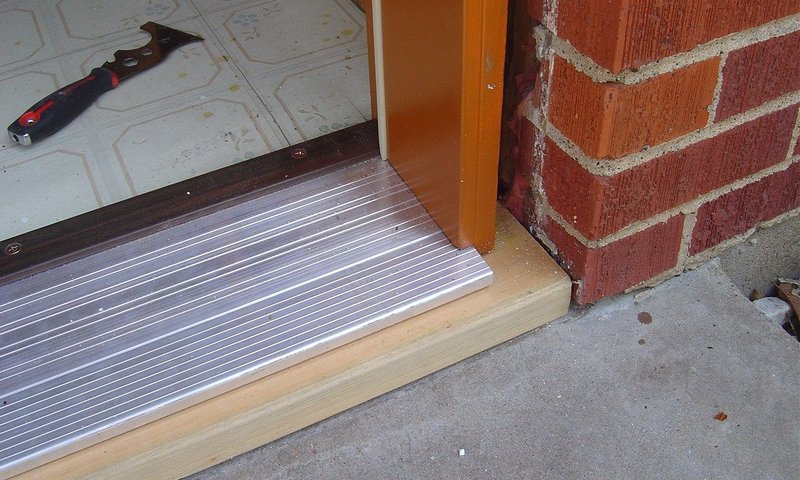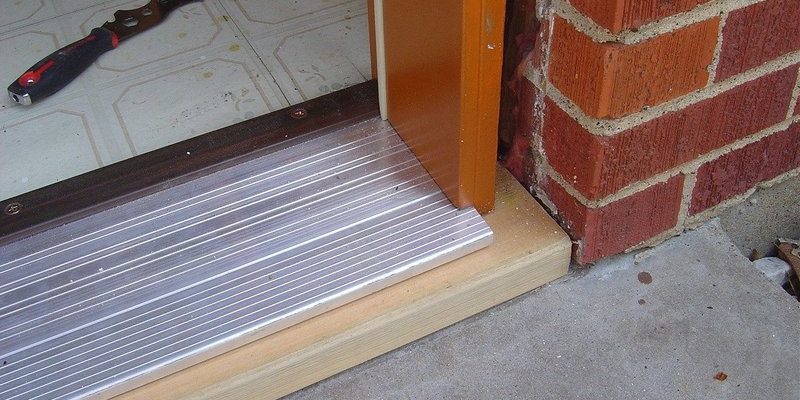
For most homeowners, especially those with heavy-duty metal or wood thresholds from brands like Pemko, Endura, or M-D Building Products, there’s nothing glamorous about maintaining this part of your door. But taking a bit of time to clean and care for it—just like you’d oil a squeaky hinge or reset a stubborn remote—pays off in smoother operation and longer life for your door. Think of your threshold as the “welcome mat” for your door—if it’s neglected, the whole entryway can start feeling tired and worn.
Let’s break down the practical steps, tools, and expert hacks for keeping your exterior door threshold looking sharp, working properly, and lasting as long as possible.
Why Door Thresholds Matter More Than You Think
Here’s the thing: most people don’t give their door threshold a second thought until it starts causing problems. But your exterior door threshold is a real workhorse. It forms a barrier against the outdoors, blocks drafts, and helps keep water and dirt from sneaking in during a summer storm or snowy winter day. Without a solid, well-maintained threshold, you risk higher energy bills, warped flooring, and even insect infestations.
Let me explain a bit further. That slim metal or wood strip is tightly paired with the bottom of your door and its seal. If dirt or debris collects, the door can stop closing properly—or worse, start grinding the threshold and wearing it down. Over time, neglecting routine cleaning is a little like forgetting to replace worn-out batteries in your remote control: suddenly, nothing works right, and you’re left troubleshooting something that could’ve been an easy fix.
Regular cleaning and occasional maintenance are simple compared to the hassle of repairing a damaged threshold or door seal later on. It’s like brushing your teeth—you don’t see the payoff every day, but you sure notice if you skip out for too long.
How to Clean Your Exterior Door Threshold
Start with the basics. No matter the brand—Pemko, Endura, M-D, or something generic—every threshold gets a buildup of grime over time. Here’s a step-by-step walk-through anyone can handle, no experience necessary:
- Grab your supplies: You’ll need a small broom or vacuum, a soft brush, mild dish soap, a bucket of warm water, an old toothbrush, and a clean rag or towel.
- Remove loose debris: Sweep or vacuum the threshold to get rid of dirt, leaves, or pebbles. This keeps you from grinding grit into the surface later.
- Scrub with soapy water: Dip your brush or toothbrush into your soapy water and gently scrub the whole threshold, paying special attention to corners and grooves where gunk likes to hide.
- Wipe and dry: Use a clean, damp cloth to wipe away soap and residue, then dry everything thoroughly with the towel. Moisture left behind can cause wood to warp or metal to corrode.
It might sound overly simple, but the trick is in the details—those small grooves, rubber gaskets, and joint lines are where problems sneak in. Even if your threshold looks fine at a quick glance, giving it a careful scrub reveals hidden grime that might be messing with your door’s perfect seal.
How Often Should You Clean Your Door Threshold?
You might be wondering if this is a weekly chore or a once-in-a-blue-moon thing. Honestly, there’s no one-size-fits-all answer. The frequency really depends on where you live and what your entryway faces:
- High-traffic or muddy areas: Clean every 1–2 weeks, especially after storms or heavy use.
- Mild climates or covered porches: Once a month should do the trick.
- Winter seasons: Check more often—salt, grit, and melting snow build up fast.
Think of it like changing batteries in a remote—sometimes you go months, other times you need to swap them out twice in a month because you’re using it constantly. If you notice your door sticking, not sealing right, or water pooling inside, that’s your sign it’s time for a cleaning even if you just did it last week.
Fixing Common Threshold Problems: What to Watch For
Not all issues can be solved with soap and water. Sometimes, your threshold needs a bit more love. If you spot scratches, dents, warped spots, or the rubber seal looking chewed up, it’s time to act—waiting only makes the fix harder.
Let’s break down some frequent offenders:
- Loose screws or fasteners: Grab a screwdriver and tighten them up. If the holes are stripped, switch to a slightly wider screw or use a wood filler for a tighter fit.
- Damaged rubber or weatherstripping: You can pick up replacement strips at most hardware stores. Cut to size, remove the old one, and stick or screw the new one into place.
- Corroded metal or rotting wood: Light surface rust can be scrubbed away with steel wool and a rust remover. For deeper damage, you’ll need to replace the affected section, much like pairing a new remote when the old one’s beyond repair.
Don’t wait for small issues to turn into door-sized disasters. Minor repairs now can save you a week of troubleshooting headaches later.
Tips for Preventing Future Grime and Damage
Here’s where a little routine can save you a lot of hassle. You don’t need a fancy system—just a few habits:
- Place a heavy-duty doormat outside: This catches most dirt and grit before it ever reaches your threshold.
- Keep an eye on the door sweep: That rubber strip at the bottom of your door should just brush the threshold, not drag or miss it completely.
- Wipe up spills right away: If rain or snow gets inside, dry it off as soon as possible to prevent water damage and mold.
- Inspect with each season: Do a quick check for wear, loose screws, or gaps in spring and fall—prime times for weather changes.
You wouldn’t let your remote get buried under couch cushions for months, right? The same goes for thresholds: a little attention keeps everything working as it should.
Choosing the Right Cleaning Products and Tools
With so many cleaning products on the shelves, it’s easy to feel lost. The good news? Simple is usually best for door thresholds, no matter if you’ve got aluminum, brass, or wood.
- Mild soap and warm water: Safe for almost every surface and won’t eat away at seals or finishes.
- Non-abrasive brushes: Soft bristles get into grooves without scratching metal or wood.
- Microfiber cloths: These pick up dust and dry surfaces without leaving lint behind.
- For stubborn marks or mildew: Diluted vinegar (about 1:5 with water) works for most—but test a small spot first, especially on brass or coated finishes.
Honestly? Don’t overthink it. The same way you wouldn’t pry open a remote with a steak knife, don’t use harsh chemicals or steel brushes that could do more harm than good.
When to Repair, Replace, or Upgrade Your Threshold
Cleaning and quick repairs work for everyday wear, but sometimes thresholds reach the point where they can’t be saved. Here’s how to know when it’s time to step up:
- Heavy corrosion or deep rot: If metal turns flaky or wood crumbles at touch, cleaning won’t cut it. Time for a new section.
- Constant drafts, leaks, or pests: If you’ve cleaned, tightened, and still have issues, upgrading to a modern, weather-sealed threshold can make a huge difference.
- Visible gaps or damage to the door bottom: Sometimes, both the threshold and door sweep need a “sync”—replace them together for the best seal.
Swapping a threshold isn’t as intimidating as it sounds; hardware stores carry universal styles and brand-specific options. It’s a bit like upgrading your universal remote—sometimes, a small change solves big headaches.
Maintaining Different Types of Thresholds: Wood, Metal, and Composite
Not all thresholds are created equal. Each material needs different care, much like the difference between using AAA batteries or a rechargeable pack in your remote. Here’s what you need to know:
- Wood thresholds: These look great but need the most attention. Clean gently, and check for cracks or rot. Reseal or paint yearly to block moisture.
- Metal thresholds (aluminum, brass): Durable and low-maintenance, but watch for scratches and surface rust. Clean with soapy water, dry thoroughly, and apply a touch of car wax for extra protection.
- Composite thresholds: A mix of materials that resists rot and weather. Clean as you would metal but don’t use harsh chemicals—they can break down the surface coating.
If you’re ever in doubt, check the brand’s care guide or search their website. It’s like reading the instruction manual before you reset your remote—sometimes the answer’s right there, and it makes the job way easier.
Wrapping Up: Keep Your Threshold in Top Shape
It’s easy to forget about your exterior door threshold until it starts causing trouble, but a little routine care goes a long way. Regular cleaning, quick repairs, and knowing when to swap out damaged parts keeps your entry smooth, secure, and welcoming—no matter what the weather throws at you. Just like syncing up your favorite remote, a little attention now saves you from bigger, pricier repairs down the road. Take five minutes now and again, and you’ll keep your home’s first line of defense working (and looking) its best.
